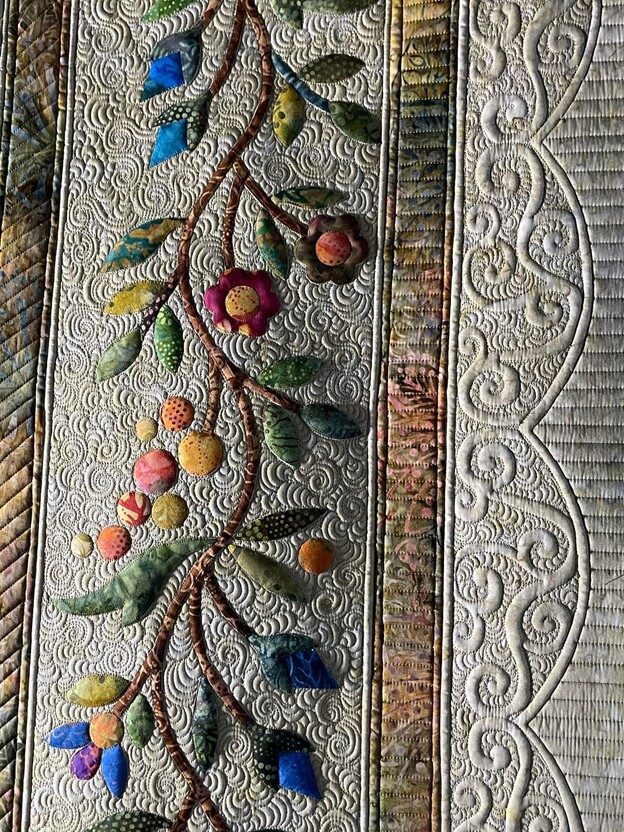How Karen McTavish finds quilting inspiration
Editor’s note: Karen McTavish is an award-winning quilter who owns and operates McTavish Quilting Studio – APQS Duluth in the Northwoods of Duluth Minnesota. She is known for her stunning quilting and her ability to use longarm machines to replicate traditional hand-quilted effects. In this article she shares her sources for quilting inspiration.

One of the first things I do to get inspiration for quilting designs is to get a sense of the overall impact of the quilt – before it is quilted. To do this, I will lay out the quilt flat on a design wall and take a photo of the quilt.
Next, I will look for the fabrics that will show my quilting design the best – this is always the plain solids in the quilt. A busy print will rarely show quilting, so I tend to focus on the solid fabrics.
Once I have established where my most complex designs will be in the quilt – I will move on to the design of the quilting.

Quilting, like music, has many types of genres. You’ll have to figure out what genre of quilt you are designing. Are you quilting a traditional or modern quilt? Are you quilting a pictorial or contemporary quilt? What sub-genre of quilt are you quilting? I recommend you break it down to the historical elements of the quilt to find the quilting element that works for this quilt.
For example, if the quilt is only using 1930s fabrics, it would be important to use quilting designs from this era, essentially matching the piecework and the quilting work. If the quilt is modern, you can throw all tradition out the window and let your freak flag fly.

Another thing I will use for inspiration is my very big collection of plastic quilting stencils. The plastic stencils are meant to be used to mark the design directly to the fabric. While this requires some extra time to pre-mark the quilt, I find that it’s worth it.
Today, we might find computerized quilting to be our new collection of ideas. I may only use a portion of a plastic stencil as a motif and modify the stencils to create a new design. I can also drop a quilting motif right from the APQS Quilt Path computerized quilt system into a block or border instead of marking the fabric directly. Quilt Path is a huge time saver.
Another way to design a quilt is to look for inspiration outside of the quilting industry all together. You can find inspiration all around you: in architecture, tattoos and digital art. Trust me when I say that these industries are looking at our industry for inspiration as well.

One way to feel creative is to try not to copy others’ work. I like to get out the paper and pen to sketch the design I am going to quilt before I load the quilt. Having a plan of attack before the quilt is loaded will result in a well-desgined quilt. I will plan the quilting around the time and effort it takes to make the quilt top. The more complex the quilt top, the more complex the quilting.
I like to use large paper and draw out the quilt design on paper, then lightbox & mark the design directly onto the quilt top. Today, we have Quilt Path to give us perfect quilting designs, which can be placed into a space with a few clicks of a button.

There are a thousand different ways to quilt a quilt – from edge-to-edge pantographs to complex custom quilting. Whatever tool you use, you will have to decide in your heart which way is best. When you are doing your best and listening to your heart, you will likely be quilting something pretty special.
My best advice to any quilt maker is to listen to your gut. My motto has always been: “Do the hardest thing.”



